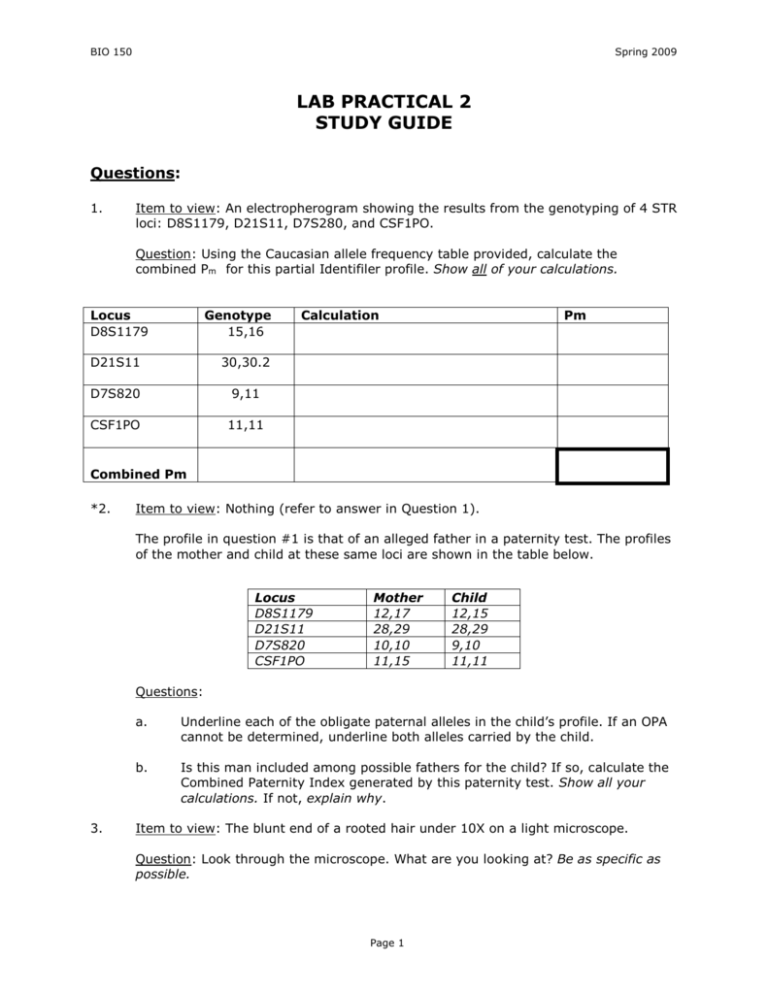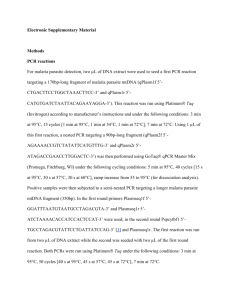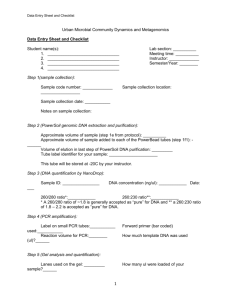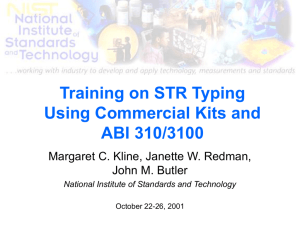PRACTICE LAB PRACTICAL EXAM 2
advertisement

BIO 150 Spring 2009 LAB PRACTICAL 2 STUDY GUIDE Questions: 1. Item to view: An electropherogram showing the results from the genotyping of 4 STR loci: D8S1179, D21S11, D7S280, and CSF1PO. Question: Using the Caucasian allele frequency table provided, calculate the combined Pm for this partial Identifiler profile. Show all of your calculations. Locus D8S1179 Genotype 15,16 D21S11 30,30.2 D7S820 9,11 CSF1PO 11,11 Calculation Pm Combined Pm *2. Item to view: Nothing (refer to answer in Question 1). The profile in question #1 is that of an alleged father in a paternity test. The profiles of the mother and child at these same loci are shown in the table below. Locus D8S1179 D21S11 D7S820 CSF1PO Mother 12,17 28,29 10,10 11,15 Child 12,15 28,29 9,10 11,11 Questions: 3. a. Underline each of the obligate paternal alleles in the child’s profile. If an OPA cannot be determined, underline both alleles carried by the child. b. Is this man included among possible fathers for the child? If so, calculate the Combined Paternity Index generated by this paternity test. Show all your calculations. If not, explain why. Item to view: The blunt end of a rooted hair under 10X on a light microscope. Question: Look through the microscope. What are you looking at? Be as specific as possible. Page 1 BIO 150 4. Spring 2009 Item to view: CODISmt printout. Questions: Examine the CODISmt printout and then answer the following questions: 5. a. Define the term SNP. How do SNPs relate to mtDNA haplotypes? b. Calculate the frequency of this mtDNA haplotype in peoples of African origin. Show your calculation and express your final answer as a FRACTION. Item to view: An electropherogram with high peak height and split peak artifacts. Questions: Examine the electropherogram. *6. a. What type of artifact do you see in this profile? b. What failed to occur during PCR that caused this to happen? Be as specific as possible. c. What would be the best way to fix the problem if you were to re-amplify the sample? Item to view: Nothing Question: Explain how ethidium bromide works as a stain for visualizing DNA. *7. Item to view: Nothing Questions: 5' - A T G T A A G A T G G C - 3' 8. a. Calculate the melting temperature of this PCR primer. Show your calculation. b. What size would a genome need to be in order for this primer to be specific enough for use in a PCR reaction? Show your calculation. Item to view: Micropipettor set for 6 uL Questions: 9. a. For what volume is this micropipettor set? Express your answer in uL, mL, and L. b. What is the highest volume that you can accurately pipette using this micropipettor? Item to view: A printout of the results of a q PCR run. Page 2 BIO 150 Spring 2009 Questions: Examine the qPCR printout. 10. a. What is the concentration of human DNA in the sample indicated by the arrow? Be sure to include units! b. Assuming that this sample was diluted 1:75 prior to quantification, calculate the volume of undiluted DNA extract you would need to add to a Minifiler reaction to ensure that the amplified product would equal exactly 0.1 ng. Can you micropipette this volume accurately? If not, what could you do to remedy the situation? (NOTE: Minifiler reactions can only accommodate up to 10 uL of DNA.) Item to view: Photo with a gel containing two bands (A and B). Questions: *11. a. What are the two functions of the loading dye used during agarose gel electrophoresis? b. Examine the photo of the gel. Which band of DNA has a higher molecular weight? Explain. Item to view: Nothing. Question: The mutation rate of mtDNA is 10 times higher than that of nuclear DNA. What are the two primary reasons for this? *12. Item to view: Nothing. Question: After generating an STR profile from a genotype, an analyst must always check over the data and may make manual adjustments. Fill in the table below, listing 3 biological and 3 technological reasons why manual intervention is necessary. Biological *13. Technological Item to View: Nothing. Questions: A single, rooted hair is found in a black ski cap left at the scene of a robbery. STR typing of the hair yields a full profile that matches the profile generated from a buccal swab taken from the main suspect in the case - with the exception of the alleles at one locus, D7S820. At this locus, the hair types as (10,12) while the buccal Page 3 BIO 150 Spring 2009 swab DNA types as (10,12,13), with the 13 allele being only about ¼ the peak height of the other two. *14. a. Assuming that the 13 allele is reproducible when the buccal swab DNA is analyzed a second time, what is the most likely explanation for these results? b. As an analyst, what could you do to test whether your explanation is correct? Item to View: Nothing. Questions: Below is a human DNA sequence and you wish to amplify the entire sequence using PCR. 5'-AAGAGATAGATCTCTCCCCTCGCTGCTCGTACTCGCTCGATCTACCCAACTCTAGCTCATTCCTC-3' 3'-TTCTCTATCTAGAGAGGGGAGCGACGAGCATGAGCGAGCTAGATGGGTTGAGATCGAGTAAGGAG-5' *15. a. Design a set of primers to accomplish this task. Label the 5' and 3' ends of each primer. b. What annealing temperature would you use in your PCR reaction? Briefly explain how you arrived at your answer. Item to View: Nothing. Question: During the QIAGEN QIAamp DNA spin column DNA extraction procedure, chemical waste was generated. What was present in this waste that made it toxic? *16. Item to View: Nothing. Question: In the space below, write out the sequence of the 11.3 allele of any typical human DNA identification STR marker. EQUATIONS: Pm = p2 + [(p)(1-p)(0.01) Pm = 2pq Ppopulation = Pdatabase + 1.96 1/2 (Pdatabase)(1- Pdatabase) N Pdatabase = X/N Ppopulation = 1 - 0.051/N PI = 0.5/(freq OPA) PI = 1/(freq OPA) Page 4









